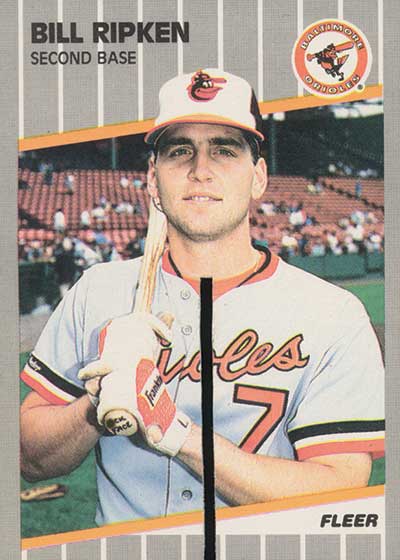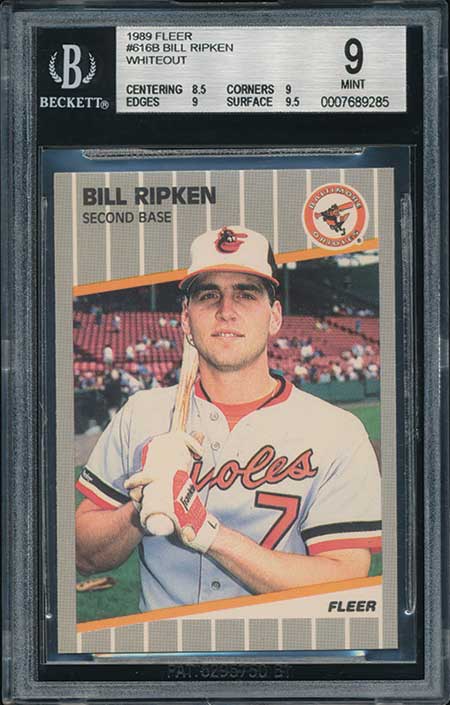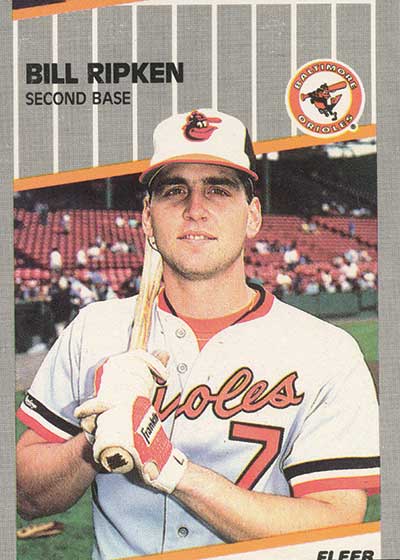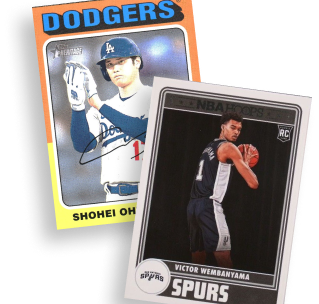History of the 1989 Fleer Bill Ripken F-Face Card and Its Many Variations
How did I get my start with this, you ask? How did I become so fascinated with the 1989 Fleer Billy Ripken F-Face card?
I collected cards from 1980-1983, football and baseball, mostly. With baseball, I was tempted to get back in with players like Don Mattingly and Jose Canseco as they became stars. As a teenager, my money was better spent on gas and going out with friends.
Reading about the FF card in the newspaper drew my interest. That was in January 1989. I thought it was a great story, especially because Billy was Cal’s younger brother. You know, the whole Ripken family thing. Baseball royalty. If it had been someone else it probably wouldn’t have drawn as much attention. It had all the makings of a little brother prank.
Well, I had to have one.

This was before all of the corrections. I just wanted to have one to put on my shelf, so I went to my local baseball card shop to see it in person, but they didn’t have one. So I bought about a dozen 1989 Fleer wax packs, but struck out. The shop owner mentioned a card show in town later in the month.
I attended the show, saw my first FF card in person and left with the card and $20 less in my wallet. It was exciting. It felt like a historic card to me, but it was only a month old.
I started to collect again, focusing on Bo Jackson and Ken Griffey Jr. and then later I began to pick up several FF-related variations as Fleer tried to “fix” the situation. Right away, I knew there were variations within the variations. For example, price guides listed a ‘Black Scribble’ version but it was very clear to me and others that there were at least two different variations of it. Same thing goes for the Black Box correction. You could clearly see again that there were at least two different variations of that so-called correction.
This was before the internet, so there was really no way to easily document stuff like this. I would just collect a few cards here and there then I headed off to college – leaving card collecting once again – but still keeping my first FF card on my shelf.
Fast forward to the late 1990s and the discovery of eBay. I didn’t have much money to spend at the time, but it was quite an experience to actually see so many different cards that I had never seen before. I knew immediately this was a tool that was going to change card collecting worldwide. A few years later I decided to look up what Billy Ripken FF cards were selling for. Unfortunately, my $20 investment in 1989 was now worth about $10. I knew it was never a rare card, but still, I was a little disappointed. I figured supply and demand was in effect.
I searched and found dozens of Ripken FFs for sale at one time. That led me to a guy in California who seemed to have a real interest in (and knowledge of) the FF card. His name was Donovan Ryan, and he was on a mission to gather all the information he could about the card. He was selling those ‘variations within variations,’ and it was the first time I had met someone that recognized these differences and was as interested in them as I was.
We shared stories and traded some cards. I was back at it — in complete F-Face mode — and it was cheap collecting, which made it more fun.
Around 2005, we tossed around the idea of creating a website completely dedicated to the FF card – that’s how into it we were. From there, the idea came to fruition and BillRipken.com was set up primarily to collect information. We wanted ex-Fleer employees to email and share stories. We wanted to go beyond the card itself. People sent me scans of articles from all over the country they had saved from 1989. Others sent emails with theories and ideas.
Fleer has been out of business for over a decade but I’m always looking for former employees to contact me – people that were there when 1989 Fleer was released.

Lots of 1989 Fleer Bill Ripken F-Face Variations
What we have discovered is that, basically, there are about five main variations of the card recognized by grading com-panies and the price guides. But in reality, there actually are a dozen or so more.
The five main variations are:
- F-Face original
- Black scribble
- White scribble
- Black box
- Whiteout (more on this later)
But, as I said, there are many, many more. Here are a few:
Saw-Cut or Slit
In an attempt to mark already printed sheets of cards containing the FF, Fleer cut huge stacks of 132 sheets (the FF was in the middle on the bottom row making it somewhat easy to mark (cut) and remove. Many versions – maybe most of them – can be found with and without these saw-cuts. The cuts were meant to mark the FF for removal before the cards were distributed into packs to be sold. Of course, thousands made their way past this step and ended up in packs.

Black Scribble
Horizontal black scribble pattern over the FF. This one can be found in three distinct variations: (1) Scribble w/ F – this one has the first letter F clearly visible; (2) Scribble w/ Loop – same scribble as #1 but with an airbrush loop coming down removing part of the first F. (3) Scribble the first letter F is completely removed.
Black Box
Black square over the FF. But a few subtle differences can be found: (1) Black Box with four square edges. (2) Black Box with a rounded up- per left corner. These were produced in full 132-card sheets of only this card. (3) Same as #2 but with what we call a “jagged white” upper left line. Not on the bat knob but on the upper left of the card itself. See the Whiteout below for more information. These Black Box cards were produced on regular 132-card sheets.
Black Box Glossy
This is a Rounded Black Box card that is only FF version to be included in the glossy set. These have the blue “Collector’s Edition” of all the glossy cards.

Circle Scribble
There are four distinct versions of this. I started referring to these as CS1, CS2, CS3 and CS4 to keep it simple. Just four different levels of coverage on the bat knob. Light to dark and less FF underneath visible. Nearly all of these have the factory saw-cut but some have been found without.
Double Dies
More of a print defect than a true version but highly collectable. A layer of ink offset. There are great examples of the FF variation with the words doubled. Twice the fun!
Whiteouts
This is where the debate begins. Price guides and grading companies have always listed these. For the record, I don’t know if these are real or not. I’m not entirely sure if these are post-production creations from Fleer or homemade fakes. I’ve never pulled one from a pack myself but have heard of people pulling them from packs. Nothing confirmed. An article written by Dick Gilkeson in Tuff Stuff magazine years ago mentions a ‘White Box’ but not an airbrushed looking white circle or oval. The FF card came out before pictures were readily available online. Maybe people didn’t know what the ‘White Scribble’ looked like and made these to fool collectors. Some collectors swear that all of these are fake. I tend to agree but – and this is important – I can’t rule it out altogether. A characteristic that many Whiteout cards is the ‘jagged white’ upper left line mentioned earlier with the Black Box cards. That would likely suggest that the Whiteout is covering up a Black Box underneath. Why would this be? One of the many questions. I would like to know if anyone actually pulled one of these from a pack. I’ve never seen one top of a pack.

Print Defects and Oddballs
When you get this deep into one particular card, you tend to expand the list. I’ve been fortunate to add several oddball-type FF cards over the years. Some may have subtle print dots on them but others have more dramatic differences. Cards with blank fronts, inked out backs, miscuts, print lines and even an entire card’s ink run on top of the FF card. It’s certainly possible that several of these cards likely were smuggled out of the factory by workers to be sold or found by collectors digging outside in trash dumpsters. One man’s trash is another man’s treasure.

Why the 1989 Fleer Bill Ripken Is Still Popular Today
Here we are, decades after it was first discovered, and the Billy Ripken F-Face card remains one of the most scrutinized, talked about and memorable cards of the 1980s. An F-Bomb on a MLB licensed card along with the Ripken name – it was the perfect storm. During the era of ‘Junk Wax’ and overproduced product, this card stood out to many. It still does. It isn’t expensive and it’s readily available and everyone can own one. The card makes for a great conversation piece.
What makes it so popular today is the fact that a lot of people that don’t collect baseball cards or even follow sports have heard of the FF. Most people have heard of Cal Ripken.
Not a year goes by when something new or different pops up in terms of collecting the FF card. I’ve been fortunate to acquire several unique items, sometimes from fellow collectors, sometimes on eBay, and sometimes from random people who have reached out to me via the website.
But information on how the card even happened? Not so much. Darren Rovell wrote a great piece for CNBC in 2008 that got lots of attention and brought thousands of clicks to the website. He got Billy’s con-fession and provided a great back story to the FF card. I think it was the first time Billy actually admitted writing on the bat himself. Prior stories had a teammate, or even Cal Jr., writing it.

I’ve been asked how many copies I have of the FF card and its variations. But I’m not hoarding FF cards. I generally try to get one of everything that is different and stay clear of doubles. Still, I can’t pass up good deals when they appear. That helps when it comes to trading with other FF collectors. In all, there are a couple hundred FF cards in my collection. Regular FF versions, variations, print defects, autographs, cello packs, uncut sheets and other related items.
White Box and the Circle Scribble
Previously mentioned collector Dick Gilkeson was the first, I believe, to document several previously undocumented variations. He listed many versions that people like me know existed but weren’t recognized in the mainstream collecting fraternity nor in mainstream magazines and price guides. The toughest of those being what he referred to as a ‘Semi-Airbrush variety with a very light and unique scratch pattern.’ The picture he included in his article (of course black & white and poor quality) matched a small random picture that was included in the monthly Beckett Baseball price guide (which didn’t mention anything special about the picture). FF collectors knew it existed but nobody had one. I found my first one on eBay in early 2006. Finally got to look at one up close and examine it personally. It instantly became my favorite card. Another example of a $5 eBay purchase that means so much.
After doing sharing scans pictures with other FF collectors, we came up with the term ‘Circle Scribble.’ It’s a light black circular airbrushed pattern. Very unique and certainly different from the other basic Black Scribble versions. Over the years, a few dozen of these have been found and it was determined that there are actually at least four different types of these ‘Circle Scribbles.’ All have the same black circular pattern but have different levels of cover- age, color and other slight differences. Of all the ‘Circle Scribble’ cards I’ve seen, more than 90% (if not more) have a factory saw-cut. It’s extremely difficult to find one without the bottom cut.
Gilkeson referred to a ‘White Box’ version as possibly being the toughest. I’ve owned a few of these that I’d consider ‘White Box’ cards, but they all appear different and are probably post-production creations from Fleer. I consider the ‘Circle Scribble’ to be the rarest true version.
Here’s a great story from my good friend and fellow FF collector Donovan Ryan (who was instrumental in creating the BillRipken.com website): He picked up what appeared to be a ‘Circle Scribble’ on eBay for a few dollars. The seller was from the Philadelphia area (think Fleer) and sold mostly odd antiques and only a couple baseball cards. It was the first uncut (no saw-cut) we had ever seen. Unfortunately, the card arrived unprotected in a plain white envelope. A Near Mint-Mint card was creased and now grades out as a VG at best. Bummed? Sure, but the card is still incredibly rare. If we had known, we probably would’ve flown out there to pick it up in person. A true needle in a haystack find.
If there are other legitimate variations out there that have not yet been catalogued, you can bet that they’ll be found. Even all these years after it first made national headlines, the Bill Ripken FF card – and the multiple variations Fleer tried to fix the ‘mistake’ – remain an intriguing part of baseball card history and Americana.








Interesting article. So I remember pulling one from a pack back in 1989 that had a white box. I was at a card shop and the owner instantly bought it from me. I didn’t remember anything other than that… I was only 12 but it’s o e of the few memories I recall quite clearly. I’ve not seen one online similar to what I remember.